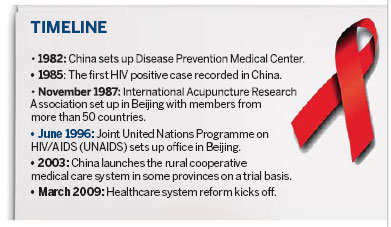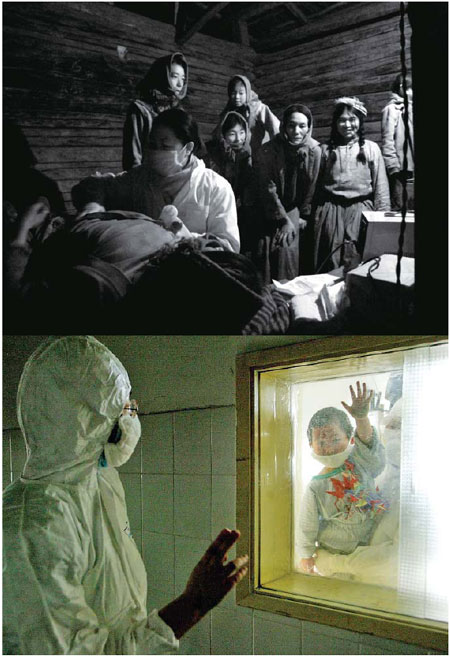Finding the right cure
|
Top: A doctor examines a female patient at the Muli Tibetan autonomous county in Sichuan province in 2005. Two doctors used horses to carry medical instruments and medicine across 12 mountains to reach the area. Above: 3-year-old Zhou Foran waves to a medical worker at Beijing Ditan Hospital, a designated hospital for SARS patients on May 30, 2003. Zhou and other children received International Children's Day gifts from the staff of Beijing Children's Hospital. Top: Hua Er / for China Daily; Above: Li Taihang / China Daily |

During the last 30 years, the health service system in China has made several significant strides and improved the overall health condition of urban and rural Chinese citizens. Though much of the focus in those days was on public health and preventive treatment, it also had some shortcomings. An inherent flaw of the post-1980s period was that healthcare became more of a fee-for-service available mainly to those who could afford it. There was also a constant churn of medical personnel from the rural to the urban areas, contrary to what was envisaged by policymakers.
In 1981, 71 percent of the Chinese had access to State health facilities, while 12 years later the number had declined to 21 percent. Though the government spending on healthcare went up in the intervening years, by 1999 China ranked only 144th among the 191 World Health Organization countries in terms of per capita health expenditure.
Most of the healthcare spending in those days was on hospital care, with pharmaceuticals accounting for over 60 percent of the costs, says a World Bank report. In short, it became increasingly difficult for the rural populace, urban poor and unemployed citizens to access the nation's healthcare system. Rising medical bills, huge medical debts due to lack of health insurance and soaring medical and healthcare costs were increasingly becoming the order of the day. It was also a calamity as many of the sick people were at high risk of contracting and spreading infection.
Against these backdrops, China kicked off its much-anticipated reform in 2009 to make its healthcare service more accessible and affordable to the country's 1.3 billion people. The core principle of the reform is to provide all citizens basic healthcare as a public service, and to make the healthcare system more public oriented, says Liu Xinming, an official responsible for medical policies and regulations at the Ministry of Health.
Under the plan, the government decided to set up diversified medical insurance systems for urban employees, urban residents who do not work or are self-employed, and rural residents to bring them under insurance coverage during the next three years. At the same time, the government also decided to hike the subsidies at various levels to 120 yuan ($18) per person in 2010.
The nation also decided to press ahead with the implementation of basic medical insurance for urban residents in 2009, particularly for the old, the disabled and children. As part of these efforts, the ratio of those covered by the basic medical insurance is expected to surpass 90 percent by this year.
Huang Jianshi, a professor at the Chinese Academy of Medical Sciences, says that in most nations, health and medical service are considered top priority and given equal emphasis by policymakers. The core principle of a healthcare system is to strengthen government responsibility, make medical care affordable to urban and rural residents alike and promote social harmony and equality, he says.
That the reforms have started to make headway is clearly evident in the higher per capita spending on public health services on the Chinese mainland. Per capita spending has gone up from 15 yuan to 25 yuan in 2011, indicating that the total financial investment by all levels of governments will reach more than 30 billion yuan.
Qin Huaijin, a ministry official, says that China has made much progress in basic public health services implemented in July 2009. By last year, China had established health files for 48.7 percent of its urban citizens and 38.1 percent rural citizens.
Over 84 percent of the pregnant women and 81.5 percent of children below three years were under system management. Nearly 57 million people aged 65 and above received physical checkups, while millions of various other kinds of patients were also put under system management, including those with elevated blood pressure, diabetes and severely mentally ill patients.
According to Qin, the ministry also came out with administrative measures on information disclosure by medical and health service units last year. It requires the units offering basic public health service programs to disclose their service items, fund standards and service targets.
"China will strengthen the management of funds and complete the system for basic public service programs. Where the money goes and whether it is used in the right places will be something that needs to be measured by all levels of governments," he says.
Revamping public hospitals is the main plank of the ongoing medical and healthcare reform. Profit streams for most State-run hospitals have till now been from medical services, while drug prescriptions have bolstered operating expenses. Such a profit-driven method of management has resulted in a heavy burden on patients and led to a waste of medical resources.
Under the current reform, the government plans to provide subsidies for medical equipment, and aims to cut the involvement of public hospitals with drug sales to cut medicine and medical checkup charges. The income for State-run hospitals will come mainly from two channels - service fees and fiscal subsidies.
Yet another target of the medical reform is to ensure equality of public medical services for both urban and rural residents. In 2006 the government decided to double the government allowances of 20 yuan for each farmer participating in the rural cooperative medical care system, says the government work report delivered by Premier Wen Jiabao to the fourth session of the 10th National People's Congress.
China launched the rural cooperative medical care system in some provinces on a trial basis in 2003 and it had covered 671 counties with a total of 177 million rural residents by 2005, says the report. Under the new policy, a farmer contributes 10 yuan every year into his personal medical care account, while the government injects another 40 yuan.
Efforts have also been made to step up healthcare facilities in rural areas. The central and local governments have spent 10.5 billion yuan to establish a disease prevention and control system that operates at provincial, city and county levels over the past three years. In addition, the government has also spent 3 billion yuan to support the establishment of health clinics in towns and townships in the central and western regions.
(China Daily 06/01/2011 page9)



















